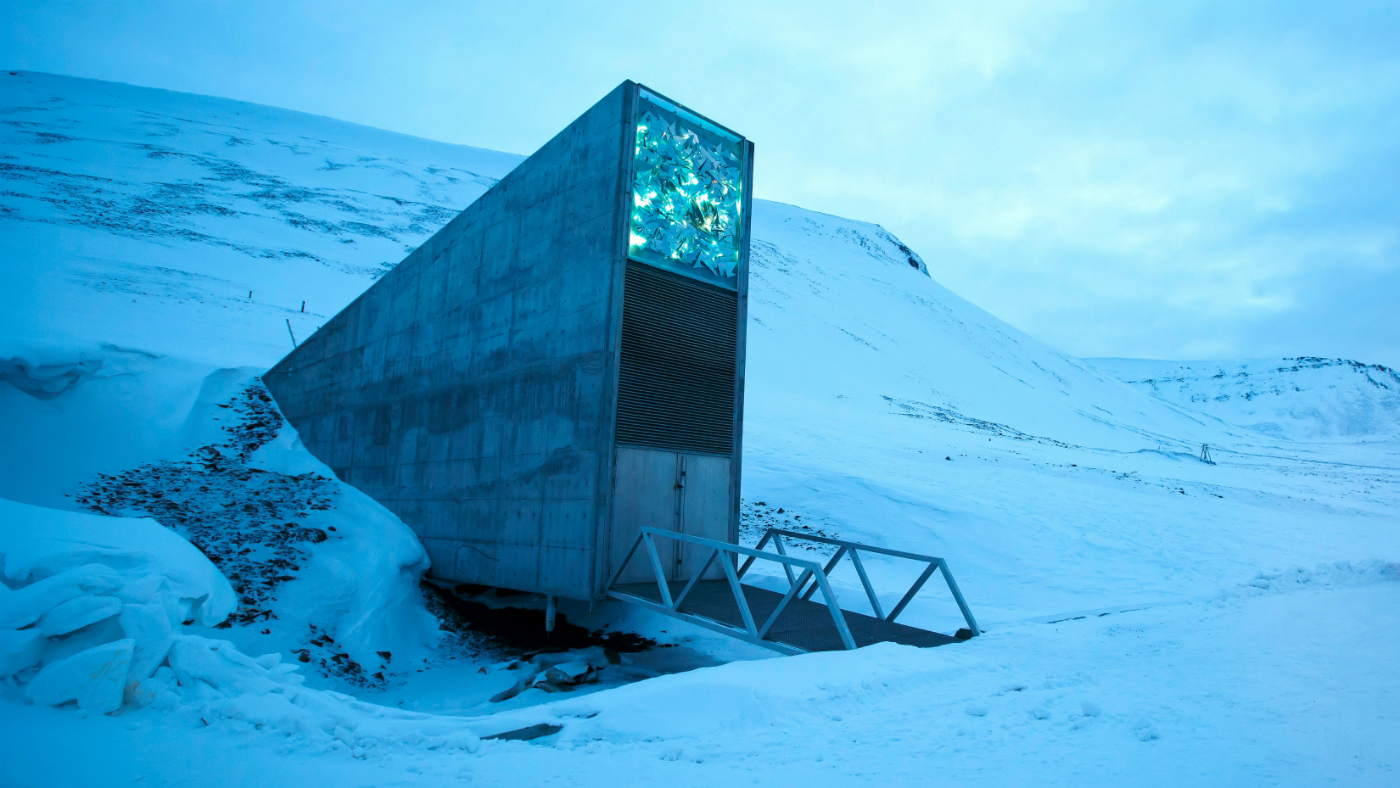What is in the Arctic doomsday vault?
A further 60,000 seed samples to be added to Norwegian bunker in bid to protect plant varieties from global catastrophe

An Arctic bunker full of seeds dubbed the “doomsday vault” is set to receive thousands of additional samples this week, pushing the total number of seeds it holds to over 1 million.
The Svalbard Global Seed Vault (SGSV), buried deep in a mountainside on the Norwegian archipelago of Svalbard in the Arctic Circle, is designed to hold a huge variety of plant seed samples as back-up stock in case of a global catastrophe.
And with maintenance under way to prevent flooding, as climate change fuels the melting of permafrost around the vault, scientists have used the upgrade as an excuse to add another 60,000 crop varieties from across the world.
The Week
Escape your echo chamber. Get the facts behind the news, plus analysis from multiple perspectives.

Sign up for The Week's Free Newsletters
From our morning news briefing to a weekly Good News Newsletter, get the best of The Week delivered directly to your inbox.
From our morning news briefing to a weekly Good News Newsletter, get the best of The Week delivered directly to your inbox.
Stefan Schmitz, who manages the reserve as head of the Crop Trust, said: “As the pace of climate change and biodiversity loss increases, there is new urgency surrounding efforts to save food crops at risk of extinction.
“The large scope of today’s seed deposit reflects worldwide concern about the impacts of climate change and biodiversity loss on food production.”
–––––––––––––––––––––––––––––––For a round-up of the most important stories from around the world - and a concise, refreshing and balanced take on the week’s news agenda - try The Week magazine. Start your trial subscription today –––––––––––––––––––––––––––––––
What is the vault?
A free daily email with the biggest news stories of the day – and the best features from TheWeek.com
The SGSV is, according to the Crop Trust, a “long-term seed storage facility, built to stand the test of time - and the challenge of natural or man-made disasters”.
The stated intention of the vault, which now contains over 1 million samples, is to safeguard the seeds of the world’s food plants in the event of a global crisis.
It is situated on the island of Spitsbergen, part of Norway’s Svalbard archipelago; one of the most northerly inhabited places on Earth. The vault is around three miles from the island’s largest town, Longyearbyen, and just 600 miles from the North Pole.
Encyclopaedia Britannica says that the site was chosen for its “cold conditions and permafrost, which would help preserve the seeds in the event the vault’s cooling systems failed”.
Completed in 2008, the SGSV was built by the Norwegian government in collaboration with the Crop Trust, and reportedly has the capacity to hold around 4.5 million varieties of seeds, with individual countries providing the seed samples to be preserved.
Why is it being upgraded?
Despite being built to withstand a changing global landscape, three years ago it appeared that climate change had accelerated to a point at which the vault failed to keep up.
In spring 2017, unusually warm temperatures in Svalbard caused heavy rainfall and significant permafrost melt, causing a deluge of water which breached the entrance to the vault and flooded it.
According to The Verge, the water didn’t make it to the seeds, instead freezing in the entrance way before any damage could be done to the samples. But the incident has “raised questions over the durability of a seed bank that was supposed to operate without people’s intervention”.
The Guardian reports that a major upgrade this winter has seen the 130-metre entrance tunnel “fully waterproofed and the cooling equipment that keeps the vault at -18C moved to a new service building, so heat from the machinery can be released outside”.
“It is always dangerous to talk about something being completely failsafe and impregnable,” said Hannes Dempewolf, a scientist at Crop Trust. “In 20, 30, 40 years down the line, we will continue to monitor the situation to see whether any other upgrades are necessary.”
Why are new seeds being added?
The upgrade has prompted the introduction of 60,000 new samples into the vault, bringing the total of crop varieties to around 1.05 million – about two-fifths of the total number in the world.
As Stefan Schmitz, executive director of the Crop Trust, explains, this “demonstrates a growing global commitment – from the institutions and countries that have made deposits today and indeed the world – to the conservation and use of the crop diversity that is crucial for farmers in their efforts to adapt to changing growing conditions”.
The Japan Times reports that both common and rarer varieties of grains are being sent by institutions in countries such as Brazil, the US, Germany, Morocco, Mali, Israel and Mongolia.
-
 5 sleeper hit cartoons about Sleepy Don
5 sleeper hit cartoons about Sleepy DonCartoon Artists take on cabinet meetings, a sleepy agenda, and more
-
 Political cartoons for December 6
Political cartoons for December 6Cartoons Saturday’s political cartoons include a pardon for Hernandez, word of the year, and more
-
 Pakistan: Trump’s ‘favourite field marshal’ takes charge
Pakistan: Trump’s ‘favourite field marshal’ takes chargeIn the Spotlight Asim Munir’s control over all three branches of Pakistan’s military gives him ‘sweeping powers’ – and almost unlimited freedom to use them
-
 Femicide: Italy’s newest crime
Femicide: Italy’s newest crimeThe Explainer Landmark law to criminalise murder of a woman as an ‘act of hatred’ or ‘subjugation’ but critics say Italy is still deeply patriarchal
-
 Brazil’s Bolsonaro behind bars after appeals run out
Brazil’s Bolsonaro behind bars after appeals run outSpeed Read He will serve 27 years in prison
-
 Americans traveling abroad face renewed criticism in the Trump era
Americans traveling abroad face renewed criticism in the Trump eraThe Explainer Some of Trump’s behavior has Americans being questioned
-
 Cop30: is the UN climate summit over before it begins?
Cop30: is the UN climate summit over before it begins?Today’s Big Question Trump administration will not send any high-level representatives, while most nations failed to submit updated plans for cutting greenhouse gas emissions
-
 Nigeria confused by Trump invasion threat
Nigeria confused by Trump invasion threatSpeed Read Trump has claimed the country is persecuting Christians
-
 Sanae Takaichi: Japan’s Iron Lady set to be the country’s first woman prime minister
Sanae Takaichi: Japan’s Iron Lady set to be the country’s first woman prime ministerIn the Spotlight Takaichi is a member of Japan’s conservative, nationalist Liberal Democratic Party
-
 How does the Nobel Peace Prize work?
How does the Nobel Peace Prize work?The Explainer Activist María Corina Machado wins prestigious prize, despite public campaign by Donald Trump
-
 Russia is ‘helping China’ prepare for an invasion of Taiwan
Russia is ‘helping China’ prepare for an invasion of TaiwanIn the Spotlight Russia is reportedly allowing China access to military training